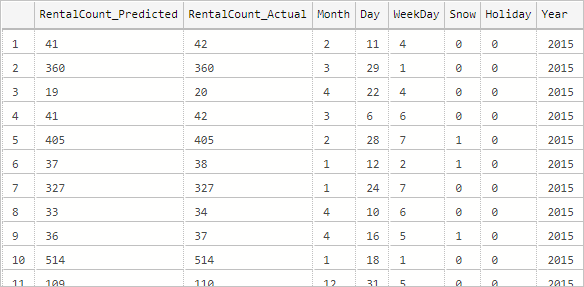Anteckning
Åtkomst till den här sidan kräver auktorisering. Du kan prova att logga in eller ändra kataloger.
Åtkomst till den här sidan kräver auktorisering. Du kan prova att ändra kataloger.
Applies to:
SQL Server 2017 (14.x) and later
Azure SQL Managed Instance
In part four of this four-part tutorial series, you'll deploy a linear regression model developed in Python into a SQL Server database using Machine Learning Services or Big Data Clusters.
In part four of this four-part tutorial series, you'll deploy a linear regression model developed in Python into a SQL Server database using Machine Learning Services.
In part four of this four-part tutorial series, you'll deploy a linear regression model developed in Python into an Azure SQL Managed Instance database using Machine Learning Services.
In this article, you'll learn how to:
- Create a stored procedure that generates the machine learning model
- Store the model in a database table
- Create a stored procedure that makes predictions using the model
- Execute the model with new data
In part one, you learned how to restore the sample database.
In part two, you learned how to load the data from a database into a Python data frame, and prepare the data in Python.
In part three, you learned how to train a linear regression machine learning model in Python.
Prerequisites
- Part four of this tutorial assumes you have completed part one and its prerequisites.
Create a stored procedure that generates the model
Now, using the Python scripts you developed, create a stored procedure generate_rental_py_model that trains and generates the linear regression model using LinearRegression from scikit-learn.
Run the following T-SQL statement in Azure Data Studio to create the stored procedure to train the model.
-- Stored procedure that trains and generates a Python model using the rental_data and a linear regression algorithm
DROP PROCEDURE IF EXISTS generate_rental_py_model;
go
CREATE PROCEDURE generate_rental_py_model (@trained_model varbinary(max) OUTPUT)
AS
BEGIN
EXECUTE sp_execute_external_script
@language = N'Python'
, @script = N'
from sklearn.linear_model import LinearRegression
import pickle
df = rental_train_data
# Get all the columns from the dataframe.
columns = df.columns.tolist()
# Store the variable well be predicting on.
target = "RentalCount"
# Initialize the model class.
lin_model = LinearRegression()
# Fit the model to the training data.
lin_model.fit(df[columns], df[target])
# Before saving the model to the DB table, convert it to a binary object
trained_model = pickle.dumps(lin_model)'
, @input_data_1 = N'select "RentalCount", "Year", "Month", "Day", "WeekDay", "Snow", "Holiday" from dbo.rental_data where Year < 2015'
, @input_data_1_name = N'rental_train_data'
, @params = N'@trained_model varbinary(max) OUTPUT'
, @trained_model = @trained_model OUTPUT;
END;
GO
Store the model in a database table
Create a table in the TutorialDB database and then save the model to the table.
Run the following T-SQL statement in Azure Data Studio to create a table called dbo.rental_py_models which is used to store the model.
USE TutorialDB; DROP TABLE IF EXISTS dbo.rental_py_models; GO CREATE TABLE dbo.rental_py_models ( model_name VARCHAR(30) NOT NULL DEFAULT('default model') PRIMARY KEY, model VARBINARY(MAX) NOT NULL ); GOSave the model to the table as a binary object, with the model name linear_model.
DECLARE @model VARBINARY(MAX); EXECUTE generate_rental_py_model @model OUTPUT; INSERT INTO rental_py_models (model_name, model) VALUES('linear_model', @model);
Create a stored procedure that makes predictions
Create a stored procedure py_predict_rentalcount that makes predictions using the trained model and a set of new data. Run the T-SQL below in Azure Data Studio.
DROP PROCEDURE IF EXISTS py_predict_rentalcount; GO CREATE PROCEDURE py_predict_rentalcount (@model varchar(100)) AS BEGIN DECLARE @py_model varbinary(max) = (select model from rental_py_models where model_name = @model); EXECUTE sp_execute_external_script @language = N'Python', @script = N' # Import the scikit-learn function to compute error. from sklearn.metrics import mean_squared_error import pickle import pandas rental_model = pickle.loads(py_model) df = rental_score_data # Get all the columns from the dataframe. columns = df.columns.tolist() # Variable you will be predicting on. target = "RentalCount" # Generate the predictions for the test set. lin_predictions = rental_model.predict(df[columns]) print(lin_predictions) # Compute error between the test predictions and the actual values. lin_mse = mean_squared_error(lin_predictions, df[target]) #print(lin_mse) predictions_df = pandas.DataFrame(lin_predictions) OutputDataSet = pandas.concat([predictions_df, df["RentalCount"], df["Month"], df["Day"], df["WeekDay"], df["Snow"], df["Holiday"], df["Year"]], axis=1) ' , @input_data_1 = N'Select "RentalCount", "Year" ,"Month", "Day", "WeekDay", "Snow", "Holiday" from rental_data where Year = 2015' , @input_data_1_name = N'rental_score_data' , @params = N'@py_model varbinary(max)' , @py_model = @py_model with result sets (("RentalCount_Predicted" float, "RentalCount" float, "Month" float,"Day" float,"WeekDay" float,"Snow" float,"Holiday" float, "Year" float)); END; GOCreate a table for storing the predictions.
DROP TABLE IF EXISTS [dbo].[py_rental_predictions]; GO CREATE TABLE [dbo].[py_rental_predictions]( [RentalCount_Predicted] [int] NULL, [RentalCount_Actual] [int] NULL, [Month] [int] NULL, [Day] [int] NULL, [WeekDay] [int] NULL, [Snow] [int] NULL, [Holiday] [int] NULL, [Year] [int] NULL ) ON [PRIMARY] GOExecute the stored procedure to predict rental counts
--Insert the results of the predictions for test set into a table INSERT INTO py_rental_predictions EXEC py_predict_rentalcount 'linear_model'; -- Select contents of the table SELECT * FROM py_rental_predictions;You should see results similar to the following.

You have successfully created, trained, and deployed a model. You then used that model in a stored procedure to predict values based on new data.
Next steps
In part four of this tutorial series, you completed these steps:
- Create a stored procedure that generates the machine learning model
- Store the model in a database table
- Create a stored procedure that makes predictions using the model
- Execute the model with new data
To learn more about using Python with SQL machine learning, see: